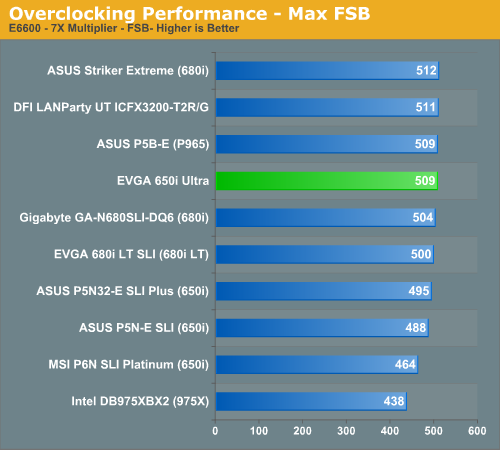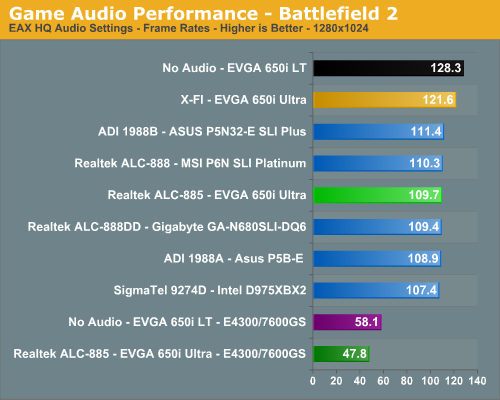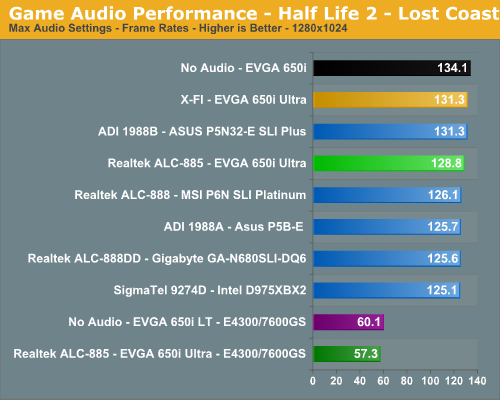EVGA nForce 650i Ultra: Performance on a Budget
by Gary Key on April 10, 2007 2:00 AM EST- Posted in
- Motherboards
FSB Overclocking

The EVGA 650i Ultra offers excellent overclocking capabilities for a $100 Intel motherboard but it quickly runs out of headroom around the 500FSB level. We believe this is a limitation of the 650i SPP based upon our results with other 650i boards. The board will not satisfy the requirements of the extreme overclocker but should be fine for a majority of users looking to extract additional performance out of their system.
We found during overclocking that we had to set the CPU voltages a little higher than on some other boards to attain the same or better overclocks. We experienced this with the MSI 650i, ASUS 650i, and EVGA 680i LT SLI boards and it was generally due to tighter memory/chipset timings in order to improve the performance of the board at stock speeds. We also had to set the SPP voltage option to 1.30V in order to ensure our memory was stable at 1T command rates due to the lack of memory voltage options over 2.10V. Overall, our overclocking experiences were great given the price, but we felt like a few extra voltage/BIOS options would have transformed the capability of this budget board from very good to excellent when considering the price to performance ratio.
Audio Performance
We are no longer showing the individual CPU utilization rates as the use of a dual core processor means the driver load is balanced between each processor with our audio solutions. The 2.3 version of Rightmark properly supports dual core processors but considering the results they are almost meaningless for most users. We have found the CPU utilization rate improvements with the dual core setup in this test do not have any bearing on actual game benchmarks as the reduction in frame rate percentages are the same on our single core systems.


The audio performance numbers remain consistent between the Analog Devices and Realtek Codecs but both finish consistently behind the SoundBlaster X-Fi in the benchmarks. This is to be expected as the ADI and Realtek Codecs are host processing units dependent upon the CPU and drivers for generating their audio streams. The SoundBlaster X-Fi on the other hand has dedicated hardware that generates its audio streams and offloads this burden from the CPU.
We are finding the CPU utilization rates to be constantly decreasing for the onboard solutions as CPU processing power increases and driver optimizations improve, but they still take a toll in certain games. This is reflected in our numbers as Battlefield 2 has an average loss of 17% and Half Life 2: Lost Coast loses 4%. We set Battlefield 2 to utilize EAX 2 in our ADI and Realtek HD results which creates another significant demand on the CPU to process the audio streams, especially with the sound effects quality set to high.
Analog Devices has made news lately claiming other host-based audio solutions (Realtek is obviously in their crosshairs) do not properly generate EAX compatible audio in their drivers. After comparing the ADI 1988B to the Realtek ALC-885 in Battlefield 2 we completely agree and this continues to be an issue even with the latest Realtek 1.64 drivers. The audio quality differences in EAX 2.0 capable games between the ADI and Realtek HD Audio Codecs are almost startling at times.
We firmly believe this is due to obstructions and occlusions still not being implemented correctly in the Realtek drivers although we have found minor improvements in the recent driver releases. There are also some bugs in EAX 2 capable games that feature outdoor areas or vast expanses: we found sounds in BF2 at one end of the map to have the same volume and distance correlation as sounds in front of the character. We suggest turning off EAX 2 in games when utilizing the Realtek solution; the games will just sound better the majority of time.
Obviously, if you are a serious gamer, then a dedicated sound card is still useful to ensure consistent frame rate averages across a wide variety of games, and in the case of the Sound Blaster X-Fi, you also get improved audio quality and EAX3/4/5 support. Unfortunately, users of Vista may have to jump through some extra hoops to get X-Fi support to work properly, due to the changes made to the Vista sound model. If you'd like more details on the Realtek or ADI solutions, you can refer to the Realtek HD Audio Codec Specifications or SoundMAX HD Audio Codec Specifications.

The EVGA 650i Ultra offers excellent overclocking capabilities for a $100 Intel motherboard but it quickly runs out of headroom around the 500FSB level. We believe this is a limitation of the 650i SPP based upon our results with other 650i boards. The board will not satisfy the requirements of the extreme overclocker but should be fine for a majority of users looking to extract additional performance out of their system.
We found during overclocking that we had to set the CPU voltages a little higher than on some other boards to attain the same or better overclocks. We experienced this with the MSI 650i, ASUS 650i, and EVGA 680i LT SLI boards and it was generally due to tighter memory/chipset timings in order to improve the performance of the board at stock speeds. We also had to set the SPP voltage option to 1.30V in order to ensure our memory was stable at 1T command rates due to the lack of memory voltage options over 2.10V. Overall, our overclocking experiences were great given the price, but we felt like a few extra voltage/BIOS options would have transformed the capability of this budget board from very good to excellent when considering the price to performance ratio.
Audio Performance
We are no longer showing the individual CPU utilization rates as the use of a dual core processor means the driver load is balanced between each processor with our audio solutions. The 2.3 version of Rightmark properly supports dual core processors but considering the results they are almost meaningless for most users. We have found the CPU utilization rate improvements with the dual core setup in this test do not have any bearing on actual game benchmarks as the reduction in frame rate percentages are the same on our single core systems.


The audio performance numbers remain consistent between the Analog Devices and Realtek Codecs but both finish consistently behind the SoundBlaster X-Fi in the benchmarks. This is to be expected as the ADI and Realtek Codecs are host processing units dependent upon the CPU and drivers for generating their audio streams. The SoundBlaster X-Fi on the other hand has dedicated hardware that generates its audio streams and offloads this burden from the CPU.
We are finding the CPU utilization rates to be constantly decreasing for the onboard solutions as CPU processing power increases and driver optimizations improve, but they still take a toll in certain games. This is reflected in our numbers as Battlefield 2 has an average loss of 17% and Half Life 2: Lost Coast loses 4%. We set Battlefield 2 to utilize EAX 2 in our ADI and Realtek HD results which creates another significant demand on the CPU to process the audio streams, especially with the sound effects quality set to high.
Analog Devices has made news lately claiming other host-based audio solutions (Realtek is obviously in their crosshairs) do not properly generate EAX compatible audio in their drivers. After comparing the ADI 1988B to the Realtek ALC-885 in Battlefield 2 we completely agree and this continues to be an issue even with the latest Realtek 1.64 drivers. The audio quality differences in EAX 2.0 capable games between the ADI and Realtek HD Audio Codecs are almost startling at times.
We firmly believe this is due to obstructions and occlusions still not being implemented correctly in the Realtek drivers although we have found minor improvements in the recent driver releases. There are also some bugs in EAX 2 capable games that feature outdoor areas or vast expanses: we found sounds in BF2 at one end of the map to have the same volume and distance correlation as sounds in front of the character. We suggest turning off EAX 2 in games when utilizing the Realtek solution; the games will just sound better the majority of time.
Obviously, if you are a serious gamer, then a dedicated sound card is still useful to ensure consistent frame rate averages across a wide variety of games, and in the case of the Sound Blaster X-Fi, you also get improved audio quality and EAX3/4/5 support. Unfortunately, users of Vista may have to jump through some extra hoops to get X-Fi support to work properly, due to the changes made to the Vista sound model. If you'd like more details on the Realtek or ADI solutions, you can refer to the Realtek HD Audio Codec Specifications or SoundMAX HD Audio Codec Specifications.










18 Comments
View All Comments
Zak - Tuesday, April 10, 2007 - link
Is there a SPDIF out bracket included? I'd find that a show stopper if it wasn't. Also, regarding the layout: with more and more video cards being quite large these days why they don't allow some extra space between the PCIx graphics slot and the next slot? This is a huge problem with mobos IMHO. Just because I want non-SLI, midrange motherboard doesn't mean I won't have a high end video card in it. Zak.saratoga - Tuesday, April 10, 2007 - link
I noticed the onboard sound benchmarks, but theres nothing about the onboard sound quality. Rightmark has a benchmark for this that take 2 minutes to run and spits out very useful information. Why not include those results like some other sites do?While knowing how it performs is great, knowing if the results are worth listening to is also important. I don't care if its the fastest onboard sound in the world, if its got poor SNR figures, I'm probably going to buy a PCI card :)
yacoub - Tuesday, April 10, 2007 - link
Added two items to your list of desired additions. If a 650i Ultra board came out with the above features, it'd be worth an additional 25% in price to me. (i.e. $125)
It's still practically amazing how well the C2D chips OC even on this board with its somewhat limited overclocking features. =)
Thanks again for a great review Gary.
yacoub - Tuesday, April 10, 2007 - link
Thanks for including the benchmarks with a real-world system. It's neat to see how incredibly different most of the test results are compared to your monster rig with XLC Flex RAM and an 8800GTX. ;)yacoub - Tuesday, April 10, 2007 - link
So don't buy this board if your DDR2 sticks want to run at 2.2v or 2.3v.
yacoub - Tuesday, April 10, 2007 - link
Ah yes, there you go:So time to wait and see if any other folks (Asus, Abit, MSi, etc) come out with a 650i board that offers better adjustment options in the BIOS.
Also would like to see a fully solid-capacitor design as well. Wouldn't mind paying $120-$125 for one of these 650i Ultras with those features added.
yacoub - Tuesday, April 10, 2007 - link
I'm really glad you posted that nice feature chart on page 2 because I didn't know that only 680i boards got the EPP compatibility. Boy it sure would suck to spend extra money on nice high-performance DDR2 RAM that advertises really nice timings when EPP is enabled, only to find out your nice new 650i SLI or Ultra board doesn't support EPP.nullpointerus - Tuesday, April 10, 2007 - link
I'll probably be getting one of these when I upgrade to C2Q late this year. From my browsing experiences, the current crop of Core-compatible boards are much too expensive or lack the new features I would like to gain by upgrading to the new platform. Kudos to EVGA for bringing a solid mid-range board to market!I'm glad to hear nTune (almost) works properly with this board. On my NF4 Ultra board, nTune crashes everytime I try to bring up the system status/overclocking stuff, and BTW the software is a pain to get working in Vista--something like six error messages come up when started without administrator permissions. Hopefully, the Vista issues will be resolved in a few months.